Explorations of catalytic domains in non-ribosomal peptide synthetase enzymology
- PMID: 22802156
- PMCID: PMC4807874
- DOI: 10.1039/c2np20025b
Explorations of catalytic domains in non-ribosomal peptide synthetase enzymology
Abstract
Many pharmaceuticals on the market today belong to a large class of natural products called nonribosomal peptides (NRPs). Originating from bacteria and fungi, these peptide-based natural products consist not only of the 20 canonical L-amino acids, but also non-proteinogenic amino acids, heterocyclic rings, sugars, and fatty acids, generating tremendous chemical diversity. As a result, these secondary metabolites exhibit a broad array of bioactivity, ranging from antimicrobial to anticancer. The biosynthesis of these complex compounds is carried out by large multimodular megaenzymes called nonribosomal peptide synthetases (NRPSs). Each module is responsible for incorporation of a monomeric unit into the natural product peptide and is composed of individual domains that perform different catalytic reactions. Biochemical and bioinformatic investigations of these enzymes have uncovered the key principles of NRP synthesis, expanding the pharmaceutical potential of their enzymatic processes. Progress has been made in the manipulation of this biosynthetic machinery to develop new chemoenzymatic approaches for synthesizing novel pharmaceutical agents with increased potency. This review focuses on the recent discoveries and breakthroughs in the structural elucidation, molecular mechanism, and chemical biology underlying the discrete domains within NRPSs.
Figures


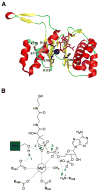

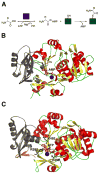


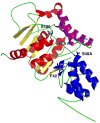
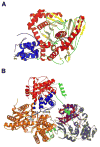

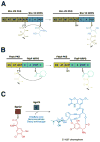




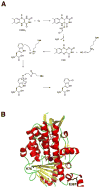

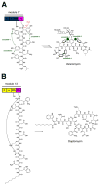






Similar articles
-
The Assembly-Line Enzymology of Nonribosomal Peptide Biosynthesis.Methods Mol Biol. 2023;2670:3-16. doi: 10.1007/978-1-0716-3214-7_1. Methods Mol Biol. 2023. PMID: 37184697
-
Piecing together nonribosomal peptide synthesis.Curr Opin Struct Biol. 2018 Apr;49:104-113. doi: 10.1016/j.sbi.2018.01.011. Epub 2018 Feb 13. Curr Opin Struct Biol. 2018. PMID: 29444491 Review.
-
Nonribosomal peptide synthetases: structures and dynamics.Curr Opin Struct Biol. 2010 Apr;20(2):234-40. doi: 10.1016/j.sbi.2010.01.009. Epub 2010 Feb 10. Curr Opin Struct Biol. 2010. PMID: 20153164 Review.
-
Recent progress in the reprogramming of nonribosomal peptide synthetases.J Pept Sci. 2024 Mar;30(3):e3545. doi: 10.1002/psc.3545. Epub 2023 Sep 18. J Pept Sci. 2024. PMID: 37721208 Review.
-
Nonribosomal peptides: from genes to products.Nat Prod Rep. 2003 Jun;20(3):275-87. doi: 10.1039/b111145k. Nat Prod Rep. 2003. PMID: 12828367 Review.
Cited by
-
Total Heterologous Biosynthesis of Fungal Natural Products in Aspergillus nidulans.J Nat Prod. 2022 Oct 28;85(10):2484-2518. doi: 10.1021/acs.jnatprod.2c00487. Epub 2022 Sep 29. J Nat Prod. 2022. PMID: 36173392 Free PMC article. Review.
-
Nonribosomal biosynthesis of backbone-modified peptides.Nat Chem. 2018 Mar;10(3):282-287. doi: 10.1038/nchem.2891. Epub 2017 Nov 20. Nat Chem. 2018. PMID: 29461527
-
Biosynthesis of novel Pyoverdines by domain substitution in a nonribosomal peptide synthetase of Pseudomonas aeruginosa.Appl Environ Microbiol. 2014 Sep;80(18):5723-31. doi: 10.1128/AEM.01453-14. Epub 2014 Jul 11. Appl Environ Microbiol. 2014. PMID: 25015884 Free PMC article.
-
Harnessing natural product assembly lines: structure, promiscuity, and engineering.J Ind Microbiol Biotechnol. 2016 Mar;43(2-3):371-87. doi: 10.1007/s10295-015-1704-8. Epub 2015 Nov 2. J Ind Microbiol Biotechnol. 2016. PMID: 26527577 Free PMC article. Review.
-
Norine: A powerful resource for novel nonribosomal peptide discovery.Synth Syst Biotechnol. 2016 Jun 1;1(2):89-94. doi: 10.1016/j.synbio.2015.11.001. eCollection 2016 Jun. Synth Syst Biotechnol. 2016. PMID: 29082924 Free PMC article. Review.
References
-
- Finking R, Marahiel MA. Annu Rev Microbiol. 2004;58:453–488. - PubMed
-
- Cane DE, Walsh CT, Khosla C. Science. 1998;282:63–68. - PubMed
-
- Stein T, Vater J, Kruft V, Otto A, Wittmann-Liebold B, Franke P, Panico M, McDowell R, Morris HR. J Biol Chem. 1996;271:15428–15435. - PubMed
-
- Weber G, Schorgendorfer K, Schneider-Scherzer E, Leitner E. Curr Genet. 1994;26:120–125. - PubMed
-
- Jirakkakul J, Punya J, Pongpattanakitshote S, Paungmoung P, Vorapreeda N, Tachaleat A, Klomnara C, Tanticharoen M, Cheevadhanarak S. Microbiology. 2008;154:995–1006. - PubMed
Publication types
MeSH terms
Substances
Grants and funding
LinkOut - more resources
Full Text Sources
Molecular Biology Databases
Research Materials
Miscellaneous

